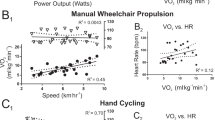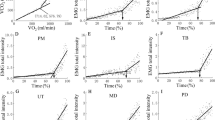Abstract
Purpose
To assess the validity of predicting peak oxygen uptake (\( {\dot{\text{V}}}{\text{O}}_{{\text{2peak}}}\)) from differentiated ratings of perceived exertion (RPE) obtained during submaximal wheelchair propulsion.
Methods
Three subgroups of elite male wheelchair athletes [nine tetraplegics (TETRA), nine paraplegics (PARA), eight athletes without spinal cord injury (NON-SCI)] performed an incremental speed exercise test followed by graded exercise to exhaustion (\( {\dot{\text{V}}}{\text{O}}_{{\text{2peak}}}\) test). Oxygen uptake (\( {\dot{\text{V}}}{\text{O}}_2\)), heart rate (HR) and differentiated RPE (Central RPEC, Peripheral RPEP and Overall RPEO) were obtained for each stage. The regression lines for the perceptual ranges 9–15 on the Borg 6–20 scale ratings were performed to predict \( {\dot{\text{V}}}{\text{O}}_{{\text{2peak}}}\).
Results
There were no significant within-group mean differences between measured \( {\dot{\text{V}}}{\text{O}}_{{\text{2peak}}}\) (mean 1.50 ± 0.39, 2.74 ± 0.48, 3.75 ± 0.33 L min−1 for TETRA, PARA and NON-SCI, respectively) and predicted \( {\dot{\text{V}}}{\text{O}}_{{\text{2peak}}}\) determined using HR or differentiated RPEs for any group (P > 0.05). However, the coefficients of variation (CV %) between measured and predicted \( {\dot{\text{V}}}{\text{O}}_{{\text{2peak}}}\) using HR showed high variability for all groups (14.3, 15.9 and 9.7 %, respectively). The typical error ranged from 0.14 to 0.68 L min−1 and the CV % between measured and predicted \( {\dot{\text{V}}}{\text{O}}_{{\text{2peak}}}\) using differentiated RPE was ≤11.1 % for TETRA, ≤7.5 % for PARA and ≤20.2 % for NON-SCI.
Conclusions
Results suggest that differentiated RPE may be used cautiously for TETRA and PARA athletes when predicting \( {\dot{\text{V}}}{\text{O}}_{{\text{2peak}}}\) across the perceptual range of 9–15. However, predicting \( {\dot{\text{V}}}{\text{O}}_{{\text{2peak}}}\) is not recommended for the NON-SCI athletes due to the large CV %s (16.8, 20.2 and 18.0 %; RPEC, RPEP and RPEO, respectively).

Similar content being viewed by others
Abbreviations
- AB:
-
Able-bodied
- BLa− :
-
Blood lactate concentration
- CV:
-
Coefficient of variation
- GXT:
-
Graded exercise test to exhaustion
- HR:
-
Heart rate
- NON-SCI:
-
Athletes without spinal cord injury
- PARA:
-
Paraplegic
- RPE:
-
Ratings of perceived exertion
- RPEC :
-
Central RPE
- RPEP :
-
Peripheral RPE
- RPEO :
-
Overall RPE
- SCI:
-
Spinal cord injury
- TE:
-
Typical error
- TETRA:
-
Tetraplegic
- \( {\dot{\text{V}}}{\text{O}}_2\) :
-
Oxygen uptake
- \( {\dot{\text{V}}}{\text{O}}_{{\text{2peak}}}\) :
-
Peak oxygen uptake
References
Al-Rahamneh HQ, Eston RG (2011) Prediction of peak oxygen consumption from the ratings of perceived exertion during a graded exercise test and ramp exercise test in able-bodied participants and paraplegic persons. Arch Phys Med Rehabil 92:277–283
Al-Rahamneh HQ, Faulkner JA, Byrne C, Eston RG (2010) Relationship between perceived exertion and physiologic markers during arm exercise with able-bodied participants and participants with poliomyelitis. Arch Phys Med Rehabil 91:273–277
Boninger ML, Souza AL, Cooper RA, Fitzgerald SG, Koontz AM, Fay BT (2002) Propulsion patterns and pushrim biomechanics in manual wheelchair propulsion. Arch Phys Med Rehabil 83:718–723
Borg GA (1970) Perceived exertion as an indicator of somatic stress. Scand J Rehabil Med 2:92–98
Borg GA (1998) Borg’s perceived exertion and pain scales. Human Kinetics, Leeds
Borg GA, Hassmén P, Lagerström M (1987) Perceived exertion related to heart rate and blood lactate during arm and leg exercise. Eur J Appl Physiol 56:679–685
Davis GM (1993) Exercise capacity of individuals with paraplegia. Med Sci Sports Exerc 25:423–432
Ekblom-Bak E, Björkman F, Hellenius ML, Ekblom B (2012) A new submaximal cycle ergometer test for prediction of VO(2max). Scand J Med Sci Sports. doi:10.1111/sms.12014
Eston RG, Brodie DA (1986) Responses to arm and leg ergometry. Br J Sports Med 20:4–6
Eston RG, Davies BL, Williams JG (1987) Use of perceived effort ratings to control exercise intensity in young healthy adults. Eur J Appl Physiol 56:222–224
Eston RG, Lamb KL, Parfitt G, King N (2005) The validity of predicting maximal oxygen uptake from a perceptually-regulated graded exercise test. Eur J Appl Physiol 94:221–227
Eston RG, Lambrick D, Sheppard K, Parfitt G (2008) Prediction of maximal oxygen uptake in sedentary males from a perceptually regulated, sub-maximal graded exercise test. J Sport Sci 26:131–139
Eston RG, Evans H, Faulkner J, Lambrick D, Al-Rahamneh H, Parfitt G (2012) A perceptually regulated, graded exercise test predicts peak oxygen uptake during treadmill exercise in active and sedentary participants. Eur J Appl Physiol 112:3459–3468
Faulkner J, Eston RG (2007) Overall and peripheral ratings of perceived exertion during a graded exercise test to volitional exhaustion in individuals of high and low fitness. Eur J Appl Physiol 101:613–620
Figoni SF (1993) Exercise responses and quadriplegia. Med Sci Sports Exerc 25:433–441
Goosey-Tolfrey VL (2005) Physiological profiles of elite wheelchair basketball players in preparation for the 2000 paralympic games. APAQ 22:57–66
Goosey-Tolfrey VL (2007) BASES physiological testing guidelines: the disabled athlete. In: Winter EM, Jones AM, Davison R, Mercer TH (eds) Sport and exercise physiology testing. Routledge, Oxon, pp 358–367
Goosey-Tolfrey VL, Lenton JP, Goddard J, Oldfield V, Tolfrey K, Eston R (2010) Regulating intensity using perceived exertion in spinal cord-injured participants. Med Sci Sports Exerc 42:608–613
Hoffman MD (1986) Cardiorespiratory fitness and training in quadriplegics and paraplegics. Sports Med 3:312–330
Hopkins W (2010) Spreadsheet for the analysis of reliability (beta version). http://www.sportsci.org/. Accessed 2013
Lamb KL, Eston RG, Corns D (1999) Reliability of ratings of perceived exertion during progressive treadmill exercise. Br J Sports Med 33:336–339
Lambrick DM, Faulkner JA, Rowlands AV, Eston RG (2009) Prediction of maximal oxygen uptake from submaximal ratings of perceived exertion and heart rate during a continuous exercise test: the efficacy of RPE 13. Eur J Appl Physiol 107:1–9
Leicht C, Bishop NC, Goosey-Tolfrey VL (2011) Submaximal exercise responses in tetraplegic, paraplegic and non spinal cord injured elite wheelchair athletes. Scand J Med Sci Sports 22:729–736
Leicht C, Tolfrey K, Lenton J, Bishop N, Goosey-Tolfrey VL (2013a) The verification phase and reliability of physiological parameters in peak testing of elite wheelchair athletes. Eur J Appl Physiol 113:337–345
Leicht C, Tolfrey K, Lenton J, Bishop N, Goosey-Tolfrey VL (2013b) Erraturn to: the verification phase and reliability of physiological parameters in peak testing of elite wheelchair athletes. Eur J Appl Physiol 113:347
Lenton JP, Fowler N, van der Woude L, Goosey-Tolfrey VL (2008a) Efficiency of wheelchair propulsion and effects of strategy. Int J Sport Med 29:384–389
Lenton JP, Fowler NE, van der Woude LHV, Goosey-Tolfrey VL (2008b) Wheelchair propulsion: effects of experience and push strategy on efficiency and perceived exertion. Appl Physiol Nutr Metab 33:870–879
Lewis JE, Nash MS, Hamm LF, Martins SC, Groah SL (2007) The relationship between perceived exertion and physiologic indicators of stress during graded arm exercise in persons with spinal cord injuries. Arch Phys Med Rehabil 88:1205–1211
McLean KP, Jones PP, Skinner JS (1995) Exercise prescription for sitting and supine exercise in subjects with quadriplegia. Med Sci Sports Exerc 27:15–21
Müller G, Odermatt P, Perret C (2004) A new test to improve the training quality of wheelchair racing athletes. Spinal Cord 42:585–590
Pandolf KB (1978) Influence of local and central factors in dominating rated perceived exertion during physical work. Percept Mot Skills 46:683–698
Paulson T, Leicht C, Bishop N, Goosey-Tolfrey VL (2013a) Perceived exertion as a tool to self-regulate exercise in individuals with tetraplegia. Eur J Appl Physiol 113:201–209
Paulson T, Bishop N, Eston R, Goosey-Tolfrey VL (2013b) Differentiated perceived exertion and wheelchair exercise in novice able-bodied users. Arch Phys Med Rehabil 94:2269–2276
Price MJ, Campbell IG (1997) Determination of peak oxygen uptake during upper body exercise. Ergonomics 40:491–499
Rodgers MM, Gayle GW, Figoni SF, Kobayashi M, Lieh J, Glaser RM (1994) Biomechanics of wheelchair propulsion during fatigue. Arch Phys Med Rehabil 75:85–93
Sawka MN, Glaser RM, Laubach LL, Al-Samkari O, Suyraprasad AG (1981) Wheelchair exercise performance of the young, middle-aged, and elderly. J Appl Physiol 50:824–828
Skinner JS, Hutsler E, Bergsteinova V, Buskirk ER (1973) The validity and reliability of a rating of perceived exertion. Med Sci Sports Exerc 5:110–115
Stöhr H, Zimmer M (1997) Wheelchair basketball from the orthopaedic viewpoint. Sportverletz Sportchaden 11:109–115
Valent LJ, Dallmeijer AJ, Houdijk H, Slootman J, Janssen TW, Hollander AP, van der Woude LH (2007) The individual relationship between heart rate and oxygen uptake in people with tetraplegia during exercise. Spinal Cord 45:104–111
van der Woude LHV, van Croonenborg JJ, Wolff I, Dallmeijer AJ, Hollander PA (1999) Physical work capacity after 7 wk of wheelchair training: effect of intensity in able-bodied subjects. Med Sci Sports Exerc 31:331–341
van der Woude LHV, Dallmeijer AJ, Janssen TWJ, Veeger D (2001) Alternative modes of manual wheelchair ambulation: an overview. Am J Phys Med Rehabil 80:765–777
Wilson PE, Washington RL (1993) Pediatric wheelchair athletics: sports injuries and prevention. Paraplegia 31:330–337
Acknowledgments
We thank Dr. Christof Leicht and Dr. John Lenton for their help during laboratory testing. Moreover, we thank the Great Britain Wheelchair Rugby Ltd, British Wheelchair Basketball and the Peter Harrison Centre for their support. Appreciation is also extended to all athletes who volunteered to participate in this study.
Author information
Authors and Affiliations
Corresponding author
Additional information
Communicated by Jean-René Lacour.
Rights and permissions
About this article
Cite this article
Goosey-Tolfrey, V.L., Paulson, T.A.W., Tolfrey, K. et al. Prediction of peak oxygen uptake from differentiated ratings of perceived exertion during wheelchair propulsion in trained wheelchair sportspersons. Eur J Appl Physiol 114, 1251–1258 (2014). https://doi.org/10.1007/s00421-014-2850-9
Received:
Accepted:
Published:
Issue Date:
DOI: https://doi.org/10.1007/s00421-014-2850-9




